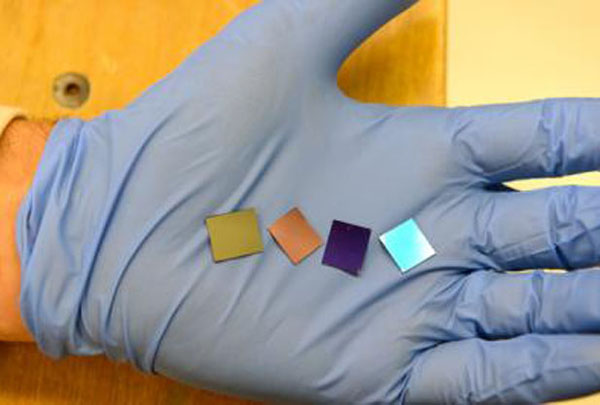Scientists at Stanford University have announced that they have created the world's thinnest and most efficient light absorber. Scientists pointed out that the thickness of this nanostructure is only one thousandth of that of ordinary paper, which not only drastically cuts costs, but also increases the conversion efficiency of solar cells. Their research has been published in the most recent issue of the journal Nano Letters (see note 1).
Stacey Bent, a professor at Stanford University who is a member of the research team, stated: “For many applications, it is advisable to achieve absorption of visible light with minimal material. Our research results have shown that there is an extremely thin layer of It is entirely possible for the material to absorb 100% of the visible wavelength of visible light."
Thinner solar cells are not only less consumable, but also less costly. The challenge for researchers is how to reduce the thickness of the battery without sacrificing the conversion rate.
In this study, the Stanford team created thin wafers with a large number of gold particles. Each gold nano dot is about 14 nanometers high and about 17 nanometers wide.

Four wafers in the hands of scientists with the world's thinnest light absorber
Visible spectrum
An ideal solar cell is capable of absorbing the entire visible spectrum from 400 nm purple light, 700 nm infrared to non-visible ultraviolet and infrared light. In the experiment, the postdoctoral scientist Carl Hagglund and his colleagues were able to adjust the gold nanoparticle to absorb one kind of light from the spectrum, that is, an orange-red light wave with a wavelength of 600 nanometers.
The author of the study, Hagglund, said: "Like a guitar string, when you dial one of the strings, the resonant frequency changes. Metal particles also have a resonant frequency that can be fine-tuned to absorb specific wavelengths of light. We adjusted the system's Optical characteristics to maximize light absorption."
The gold nano-inlaid silicon wafers are manufactured by Hitachi, an electrical and electronics company that operates in Japan, using block copolymer lithography. Each wafer contains about 520 billion nanometers of dots per square inch. Under a microscope, the hexagonal arrangement of particles is very similar to a hexagonal honeycomb array.
The Hagglund team used the atomic layer deposition process to add a thin film coating on the surface of the silicon wafer. Hagglund said: "This is a very attractive technology, because by adding a coating can make the particles more uniform, and reduce the thickness of the film to the atomic level."
“Using this process, we can change the thickness of the coating around the nano-dots to simplify the adjustment of the system. In fact, some people have established a similar array, but they did not adjust it to the best state of light absorption - —This is where our innovation for research succeeds."
Record glory
Needless to say, the research results of the Stanford research team have set a world record. Hagglund said: "Coated silicon wafers can absorb 99% of red-orange light. In terms of gold nanoparticle itself, 93% absorption has also been achieved."
Each point is equivalent in thickness to a layer of gold, only 1.6 nanometers. It is the thinnest visible light absorber in the world and is only one thousandth of the thickness of current thin-film solar cell absorbers - enough to refresh the world record.
Hagglund added: “Original record holders required absorber layers to be more than three times thicker to achieve full light absorption, and we have advanced this limit even further by optimizing the ultra-thin nano-engineering system. ."
The next step for the Stanford team is to show how this technology can be applied to actual solar cells.
Bent, director of the Stanford Energy Conversion Efficiency Nanostructure Research Center (CNEEC), said: "We are currently seeking to build structures using ultra-thin semiconductor materials that absorb solar light. We will then test these prototypes to examine their conversion efficiency."
In the experiment, researchers used three types of coating materials: tin sulphide, zinc oxide, and aluminum oxide, on different nano-dot arrays.
Hagglund said: "These coatings are not light-absorbing. However, existing theory has proved that if the semiconductor coating is used, it will be absorbed from the metal particles and absorbed from the semiconductor material. This can create longer life and Vibrant charge carriers."
Ultimate goal
Bent added that the ultimate goal of the research team is to develop performance-enhancing solar cells and solar fuels by minimizing the total amount of materials. “
She said: "This can minimize the construction of materials for the equipment. However, it is foreseeable that efficiency will be improved because by design, the charge carriers are produced in a place very close to their 'likes', that is to say close to those They gather to produce electrical currents or catalyze the chemical reaction sites."
Scientists are also considering making such nano-dot arrays with cheaper metals. Hagglund said: "We chose gold because they are more chemically stable for our experiments."
“Although the cost of gold is almost negligible, the price of silver seems to be cheaper, and from an optical point of view, the use of silver seems to produce better solar cells. The thickness of our equipment has been greatly reduced, based on this, We will eventually produce solar cells with a drastically reduced thickness."
The project research team also includes Mark Brongersma, a professor of engineering, Sabell Thomann and Han-Bo-Ram Lee, former post-doctors of Stanford University, and Gabriel from Hitachi Global Storage Technologies (Hitachi Global Storage Technologies, headquartered in San Jose, California). Zeltzer and Ricardo Ruiz. (Translator: Krystal)
Editor's note: Nano Letters is an authoritative publication in the international nanoscience and technology field of the American Chemical Society. It mainly publishes high-level academic papers that are original in nanoscience and technology.
Soap Holder,How to Install Soap Holder,Brass Soap Basket,Installing Soap Holder in Shower
Kaiping Jenor Sanitary Ware Co., Ltd , https://www.jmjenorsanitary.com
![<?echo $_SERVER['SERVER_NAME'];?>](/template/twentyseventeen/skin/images/header.jpg)